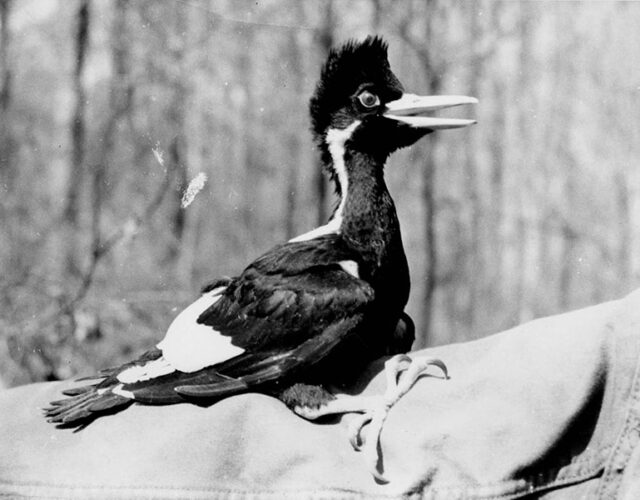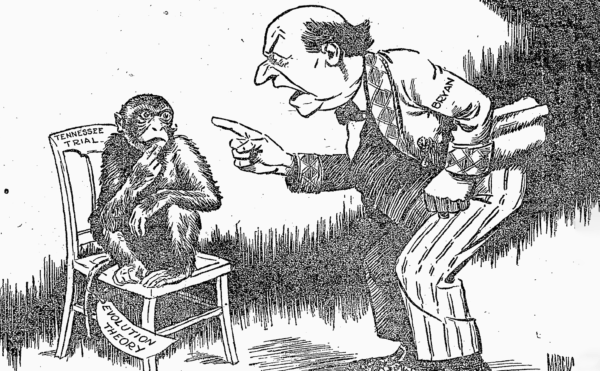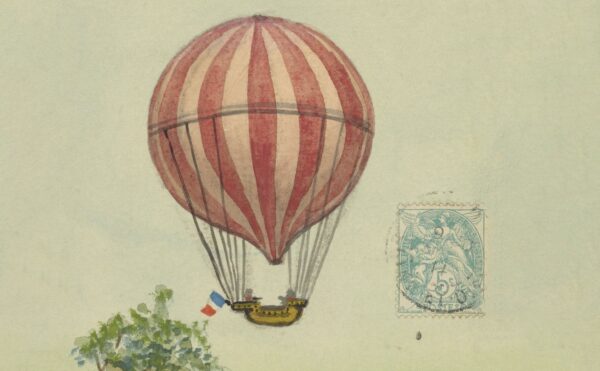The ivory-billed woodpecker is sometimes called the Lord God bird, a nickname it earned because that’s what people cried out the first time they ever saw one: “Lord God, what a bird.” Even though the last confirmed sighting was in the 1930s, birders have been claiming they have seen the Lord God bird throughout the years, turning it into a myth. The sad part is it didn’t need to be this way. And it’s all Hitler’s fault. As crazy as it sounds, the ivory-billed woodpecker was one of last victims of the Nazi war machine.
Credits
Host: Sam Kean
Senior Producer: Mariel Carr
Producer: Rigoberto Hernandez
Audio Engineer: Jonathan Pfeffer
Music by Blue Dot Sessions
All other music composed by Jonathan Pfeffer
Photo: Knoxville History Project
Transcript
As James Tanner started to climb the tree, he was tingling with excitement. It was March 6th, 1938, his 24th birthday. And he was about to glimpse one of the rarest birds in the world.
Tanner had been watching the woodpecker nest from the ground for 16 days, squinting and craning his neck. It was 55 feet up. And a few moments earlier, when the two woodpecker parents flew off to find food, Tanner had gotten a crazy idea. He decided to scale the tree, and catch a glimpse of the baby fledgling inside.
Tanner had nicknamed the fledgling Sonny Boy. It had black feathers with white racing stripes. And with every foot Tanner climbed, his excitement swelled. He began snapping branches aside, hoping Sonny Boy would poke his head out.
Unfortunately, Sonny Boy had a different perspective on the visit. After all, here was some huge featherless huffing-puffing thing breaking branches and jamming his beak right into the nest hole. As soon as Sonny Boy saw that, he panicked, and darted out the hole to fly away.
The only problem was, Sonny Boy couldn’t fly yet. He was too young. And despite being a fledgling, this was a big species of woodpecker. Sonny Boy was the size of a pigeon. So when he bolted from the hole, he plunged straight down toward the ground, his wings thrashing uselessly.
Watching Sonny Boy fall, Tanner felt his insides crater. Had he just killed one of the most endangered birds on earth?
Thankfully, no. Sonny Boy crashed into some vines, which saved him from splattering. Tanner scurried down the tree to untangle him. And what happened next was frankly kind of magical.
Still fascinated, Tanner decided to snap some photos. So he handed Sonny Boy to his guide, a local fellow named J.J. But Sonny Boy wouldn’t sit still. He hopped onto J.J.’s arm—then his back—then perched right on top of his hat. Not in panic, either. In fact, Sonny Boy seemed to be … kind of showing off. Mugging for the camera.
Now, ornithologists had heard stories like this before. That this type of woodpecker actually enjoyed attention, and would pose for people. In fact, the cartoon character Woody Woodpecker was modeled in part on this species, because it was so charismatic.
And the encounter thrilled Tanner. He’d just gotten close-ups of one of the rarest birds on Earth, one that still fascinates people today—the ivory-billed woodpecker.
You might remember a flurry of attention for the ivory-billed woodpecker in 2005. That year, reports emerged of several sightings in an Arkansas swamp—a full seven decades after the last confirmed sighting. Had this iconic species been resurrected? It was a powerful surge of hope for a country bitterly divided by war in Iraq and partisan politics. One good thing we could all rally around.
Unfortunately, the 2005 sightings were probably bogus. In fact, after Tanner replaced Sonny Boy in the nest, only one other person on Earth would ever catch a confirmed glimpse of one.
And the worst part is, it didn’t have to be this way. We could have saved the ivory-billed woodpecker—and might have, if not for, of all things, Adolf Hitler. Because as crazy as it sounds, the ivory-billed woodpecker was one of last victims of the Nazi war machine.
From the Science History Institute this is Sam Kean and the Disappearing Spoon—a topsy-turvy science-y history podcast. Where footnotes become the real story.
The ivory-billed woodpecker is sometimes called the Lord God bird. Because that’s what people cried out the first time they saw one. Lord God, what a bird.
It’s one of the largest woodpeckers on Earth, with a wingspan of 30 inches. It has a black body with sleek white stripes, and white tips on its black wings. Males have a bright red crest atop their heads.
And of course, it has an ivory-colored bill. Anatomically, the bill is a long, sharp bone covered in keratin, similar to fingernails. It’s then anchored to the skull. This enables the bird to pound holes into trees. Here’s its knock. A double knock. It then digs out beetle grubs for food. It also eats pecans, acorns, wild grapes, hackberries, even poison ivy seeds, a daring choice.
As for their call, it’s not the Woody-Woodpecker ah-ha-ha-ha-ha-ha. It’s actually a honk. Kind of an awkward sound. But their flight was always majestic. They’d sweep in low toward trees, then rush to the top in a graceful swoop. Lord God, what a bird.
The ivory-billed’s range extended from Florida up to Virginia, and as far west as Texas. Dixie, essentially. And fittingly enough, its downfall began with Dixie’s defeat during the Civil War.
The defeat left Dixie impoverished. And the ivory-billed’s natural home—the beautiful longleaf pine forests, where trees grew as tall and true as cathedral pillars, and you could ride a horse for days without dismounting—were quickly raided for cash.
The North had already destroyed its forests, and its mills needed timber. So North and South conspired to chop down millions upon millions of pine trees. Cut and get out, was the motto. Ninety million acres of virgin forest was reduced to just three.
And as those trees crashed down, so did the population of the ivory-billed woodpecker. The birds got pushed into swamps and other marginal land where they couldn’t find enough grubs to eat. Untold numbers starved, and by the 1930s, things were dire.
Young James Tanner was supposed to be the birds’ savior. He was an ornithology student at Cornell University, and in 1937 he began a three-year odyssey to track the ivory-billed across the entire South. He wanted to map their remaining habitats, and figure out what land to conserve in order to save them.
Tanner traveled around in a sputtering Model A Ford. He put in 45,000 miles total. And where the Model A couldn’t go, he plunged into forests on horseback or waded through swamps on foot, dodging mosquitos and snakes. He often slept on an old tennis net strung between trees.
He found Sonny Boy in northeast Louisiana—the fledgling he almost killed but got the incredible pictures of. And if you want to see those pictures of Sonny Boy mugging for the camera, head over to Patreon.com/disappearingspoon. They’re fascinating.
Sadly, though, Sonny Boy proved the lone highlight of the trip. Because despite crisscrossing 45,000 miles in his Model A, James Tanner saw not a single ivory-billed woodpecker outside of Louisiana. Sonny Boy’s home was their last holdout, their Alamo.
Specifically, Sonny Boy lived on land called the Singer Tract. It was owned by the Singer sewing machine company, which made wooden cabinets to house its machines. And even within that tract, Tanner found just a dozen ivory-billeds total. The species was critically endangered.
When he returned to Cornell, Tanner wrote up an urgent report. Save the Singer Tract, he said, or the Lord God Bird will disappear forever. In turn, this report fired up some well-connected conservationists, people with more resources and power than a Ph.D. student. Specifically, the report lit a fire under Richard Pough, a future president of the Nature Conservancy.
Now, Pough was a real mover and shaker, and he quickly lined up meetings with four southern governors. He pitched the idea of buying up the Singer Tract and making it a nature refuge, to save the ivory-billed from extinction. His enthusiasm was infectious, and all four governors agreed. Pough even got president Franklin Roosevelt to sign on.
Pough then approached the owners of the Singer Tract to make an offer. Now, technically Singer Sewing Machines still owned the land. But it had leased the rights to another company, Chicago Mill and Lumber. And when Pough approached the Mill, owner James Griswold was eager to sell.
By this point, March 1942, every able-bodied logger in the South was overseas fighting World War II. There was zero labor around, and the land was useless. Might as well sell it off, Griswold figured. He suggested $200,000—$3.2 million today.
Now, that was an obscene amount of money then to save a bird. But James Tanner had shown that the ivory-billed was a keystone species. By pecking holes into trees, it allowed insects to crawl inside. This infestation often finished off weak trees. And when weak trees fell, this opened up patches of sunlight and canopy to help younger, stronger trees grow. So saving the ivory-billed would strengthen the Singer forest overall.
Pough explained all this, and after some long negotiations, the governors put up the $200 grand. Pough then caught the next train for Chicago, check in hand. The ivory-billed woodpecker was one signature away from salvation.
Except, when he got there, Griswold the Mill owner reneged on the deal. Pough was stunned. Why? What happened? The Nazis, Griswold explained.
In short, the Allies had been scooping up German soldiers by the thousands in North Africa and had nowhere to put them. So they began packing them onto so-called liberty boats and shipping them to America, which had plenty of room. Nearly four-hundred thousand Nazi P.O.W.s were eventually shipped here—including 500 at a fairground in northeast Louisiana, a few miles from the Singer Tract.
And rather than let those able-bodied prisoners sit idle, the War Department put them to work. Farming mostly, but others got assigned different tasks. Like logging.
Chicago Mill owner James Griswold was tickled pink. It was practically free labor. So he told the conservationist Pough to bug off—he didn’t give a damn about some birds. Quote, “We’re just money-grubbers,” Griswold said. “We’re not concerned with ethical considerations.” The deal was off.
So sadly, over the next few years, the Singer Tract got wiped out—an all-American landscape clear-cut by the very Nazis we defeated.
But here’s the thing. At first, the Nazis were happy to cut timber. It was glorious forest, and working outdoors sure beat sitting inside a barbed-wire prison camp. But before long, the Germans began grumbling.
You see, the Chicago Mill ordered nearly every tree cut down—even the ones useless for lumber. Surplus trunks were simply left to rot.
And what was the worthwhile lumber used for? Not vital war material. Oh, no. The forest was wiped out…to make tea chests for British officers. The Nazis were disgusted. To destroy one of the last stands of untouched forest in North America, just so the Brits could have fresh Earl Grey? Even they had more ethics than that.
Conservationists were distraught, too. In April 1944, an artist with the Audubon Society visited the Singer Tract, and caught one last, lonely glimpse of an ivory-billed woodpecker there. It was female with no mate. She lived high up, within a small grove surrounded by stumps.
The artist stayed as long as he could, just watching her. Lord God. Then he heard a crash… A huge tree had just been felled behind him. He realized the Germans would be coming for this grove soon. They had orders. And with that, the artist left. He couldn’t stomach seeing the last ivory-billed cut down.
No one has seen one since. But what about that 2005 sighting in the Arkansas swamp, the one that got all the publicity? Unfortunately, it’s probably bogus.
The whole thing started with a New Age hippie. She supposedly saw an ivory-billed—and I’m not making this up—after consulting a psychic, who helped her divine the bird’s energy field. Had she at least gotten a picture? Um, no. Her camera failed.
People nevertheless ran with her story. Sightings multiplied, and some people even took videos. But they’re laughably grainy; they make the Zapruder film look high-def. And in every sighting, the bird is always masked behind a tree, or beating its wings off in the distance.
This all looks even more dubious when you realize that there’s another type of woodpecker in that swamp. The pileated woodpecker. The pileated is smaller, but it’s also black with white stripes and a red crest. It’s all too easy to mix the two species up. People simply see a half-glimpse of fluttering wings, and Lord God, their imaginations take flight, too.
In fact, the 2005 sighting isn’t even unique. Another sighting occurred in 1950. And 1955. ’58, too. Plus ’59, ‘66, ‘67, ‘71, ’75, and…you get the picture. But every single claim eventually crumbles. Thousands of birders have spent probably millions of hours searching for ivory-billeds—and so far, no one has ever gotten a clear glimpse.
The big question, then, is why? Why do people believe it exists? Confirmation bias certainly plays a role. Psychologically, people see what they want to see, and they grasp at any possible clue as proof. We all do it, birders included.
But if this was just a birding story, no one would care. There’s something deeper at work—the hope of a paradise lost and regained. The hope that, if we can just find the ivory-billed again, maybe that means humans aren’t all money-grubbers after all, trading pristine forests for cash. We’ll get once last chance to right an old wrong. As one skeptic said, it’s “faith-based ornithology.”
Even today, people still search for the ivory-billed—including people who know deep down it’s gone. In a way, I actually find that touching. That’s such a deeply human act. The head knows it’s defeated, yet the heart pushes on.
At this point, the ivory-billed woodpecker might as well be Bigfoot—a myth. But like all myths, this one has power. It’s a story of greed and hope, of near-misses and psychological delusions. Above all, it’s a story of two species in conflict—a charismatic bird whose ghost still haunts the forests, and the featherless primate with an urgent need to keep those ghosts alive.




